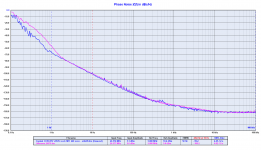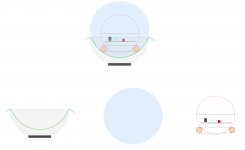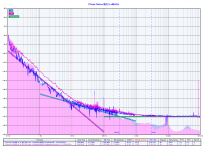Someone did ask me to publish the phase noise plot of the Crystek CCHD-957 down to 0.1 Hz from the carrier.
I attach the plot compared to the cheap TWTMC-PPG at the same frequency, I had to change the dBc scale to show the phase noise of the Crystek at 0.1 from the carrier.
Maybe after hours of measurement it could perform a little better, this measurements was 30 minutes long (even the measurement of the TWTMC-PPG).
The crystek cchd957 curve below 1Hz - is very familiar.
A heat shield/cover for convective air currents would mitigate that quite nicely. 'basta poco'..
It looks like you still have a little to learn maybe you are not yet enough familiar with phase noise measurements and crystals behaviour.
The Crystek was shielded in a metal box during the measurement so no moving air and double isolation since the crystal is already inside the can of the oscillator.
Indeed "The crystek cchd957 curve below 1Hz - is very familiar", it's a typical behaviour of a cheap crystal where the surfaces are full of impurities, that heavily affects the random walk.
I attach a comparison against another cheap "unknown" crystal I have measured in the same shielded conditions in the Pierce pico gate oscillator.
The plots are almost superimposable (remember the rule of the ruler, Rubiola teaches, I know it's tiring but it would be better if you read his literature), so no currents air simply crappy crystals.
And it's pretty obvious since it's a 20 EUR oscillator from the shelf.
The Crystek was shielded in a metal box during the measurement so no moving air and double isolation since the crystal is already inside the can of the oscillator.
Indeed "The crystek cchd957 curve below 1Hz - is very familiar", it's a typical behaviour of a cheap crystal where the surfaces are full of impurities, that heavily affects the random walk.
I attach a comparison against another cheap "unknown" crystal I have measured in the same shielded conditions in the Pierce pico gate oscillator.
The plots are almost superimposable (remember the rule of the ruler, Rubiola teaches, I know it's tiring but it would be better if you read his literature), so no currents air simply crappy crystals.
And it's pretty obvious since it's a 20 EUR oscillator from the shelf.
Attachments
Yes we've done similar experiments as well with different clock enclosures with various dampening methods, but I'd still like to see the measurements and results of what TNT proposed.
Sounds really interesting, would you be happy to share some of the experiments you have done for future implementers of Andrea's clocks, who may not have the time to iteratively test different dampening methods?
WRT Driscoll vs Differential:
I think it's worth comparing sub harmonics between differential and Driscoll. Many here will be using them for DS type DACs and as pointed out, some DS
DACs have varying sensitivity to the oscillators sub harmonics.
Also it's worth noting that if there is equal amplitude of H2/3 and H1/3 this will result in cancellation of sub harmonic induced jitter on rising edges.
Just a thought if there is nothing else to sway the decision.
TCD
A crystal oscillator will by itself not create those sub harmonics. So I would not worry about that for the oscillator choice itself. It is only by adding the frequency multipliers where you run the risk of creating those sub-harmonics. So in case you would need a high frequency clock for a noise shaping DAC system, you are probably better of using a PLL system to create this higher frequency locking to the best possible reference. However, the design and realization of such a PLL is somewhat more complicated than the clock multipliers.
From the measurement results the Driscoll -and differential style oscillator perform equally well.
To some extend there remains a small risk relying on the measurement data only as these results can only be obtained by long time averaging. So the close-in phase noise and random walk differences can still be slightly different while not measuring really differently.
As I can confirm the close-in phase noise and random walk properties of the audio master oscillator are very audible (independent of noise shaping or 'classic' DAC structure), I too am curious if Andrea is able to detect any differences (preference) in a listening test.
By the way, it remains very hard to understand the perceptual model why this aspect of the audio master oscillator is so important - even for playback of old recordings that were transferred from tape (...wow and flutter...). But since it simply is that audible, the best you can do is making sure you have the best possible clock in your audio system.
As a note aside, to my experience, the clock aspects are much more audible when listening over loudspeakers than with headphones.
pieter
My take on isolation is inspired from the good ol' recordplayer. It houses an Ian buffer with NDK clocks. It's built up by:
- The inner bowl: houses the electronic which is mounted softly isolated resting on bubble plastic.
- The outer bowl: houses the inner bowl - the inner bowl being held and isolated by bubble plastic.
- The most outer foundation half bowl: It carries the outer bowl by 2 pc of training rubber bands in a cross and they are terminated under the foundation so that the weight itself fastens the whole thing.
The attached zip file contain a short .mp4 flick of the suspension in action.
I have not done any measurement of the grade of isolation.
But I feel it improves on my DAM dac an it's not so superior jitter buffer design.
//
- The inner bowl: houses the electronic which is mounted softly isolated resting on bubble plastic.
- The outer bowl: houses the inner bowl - the inner bowl being held and isolated by bubble plastic.
- The most outer foundation half bowl: It carries the outer bowl by 2 pc of training rubber bands in a cross and they are terminated under the foundation so that the weight itself fastens the whole thing.
The attached zip file contain a short .mp4 flick of the suspension in action.
I have not done any measurement of the grade of isolation.
But I feel it improves on my DAM dac an it's not so superior jitter buffer design.
//
Attachments
In radio basestations the oscillators has always been critical - even more so as the frequencies are raised and the modulation schemes gets tighter and tighter. Also, here there are requirement on withstanding vibration - many a subway have wrecked what some cell planner thought was a safe bid. Saying that....
I would like to see vibration adressed as an potential problem and wish to see a measurement from Andrea:
Set up the same measurement as one of the latest 22,5 MHz but play pink noise from at least 1 meter distance for 85 dB at (1 kHz; +/- 3 dB 20-20k?) the location of the Driscoll.
Compare to previous silent situation.
//
why not play your favorite track and listen at three different distances - that is what it is about after all? The measurement only is interesting, but can we hear it in the perceived sound quality of the music?
My take on isolation is inspired from the good ol' recordplayer. It houses an Ian buffer with NDK clocks. It's built up by:
- The inner bowl: houses the electronic which is mounted softly isolated resting on bubble plastic.
- The outer bowl: houses the inner bowl - the inner bowl being held and isolated by bubble plastic.
- The most outer foundation half bowl: It carries the outer bowl by 2 pc of training rubber bands in a cross and they are terminated under the foundation so that the weight itself fastens the whole thing.
The attached zip file contain a short .mp4 flick of the suspension in action.
I have not done any measurement of the grade of isolation.
But I feel it improves on my DAM dac an it's not so superior jitter buffer design.
//
Very ingenious!
The video was great, lots of inspiration, thank you.
Thanks!
I'm contemplating a way to communicate with the clock by light so that no open holes in either of the bowls and no mechanical contact - even not by wire...
- Drill the 2 holes in each bowl and glue glass windows so to make a pressure tight bowl - .
- Align the windows so that the electronics can be supplied energy by light - fix solar cell power system in there...
- Send clocks by laser - receiver on the outside 🙂
Levitate everything by strong magnets and a glued iron clad in the bottom of the foundation bowl.
Well, maybe... :-D
PS: Now a use silicon to seal the holes for the cabling...
PS2: The 2 inner bowls have been painted on the inside with a total of 3 kg worth of dampening latex.
//
I'm contemplating a way to communicate with the clock by light so that no open holes in either of the bowls and no mechanical contact - even not by wire...
- Drill the 2 holes in each bowl and glue glass windows so to make a pressure tight bowl - .
- Align the windows so that the electronics can be supplied energy by light - fix solar cell power system in there...
- Send clocks by laser - receiver on the outside 🙂
Levitate everything by strong magnets and a glued iron clad in the bottom of the foundation bowl.
Well, maybe... :-D
PS: Now a use silicon to seal the holes for the cabling...
PS2: The 2 inner bowls have been painted on the inside with a total of 3 kg worth of dampening latex.
//
Last edited:
A crystal oscillator will by itself not create those sub harmonics. So I would not worry about that for the oscillator choice itself. It is only by adding the frequency multipliers where you run the risk of creating those sub-harmonics. So in case you would need a high frequency clock for a noise shaping DAC system, you are probably better of using a PLL system to create this higher frequency locking to the best possible reference. However, the design and realization of such a PLL is somewhat more complicated than the clock multipliers.
From the measurement results the Driscoll -and differential style oscillator perform equally well.
To some extend there remains a small risk relying on the measurement data only as these results can only be obtained by long time averaging. So the close-in phase noise and random walk differences can still be slightly different while not measuring really differently.
As I can confirm the close-in phase noise and random walk properties of the audio master oscillator are very audible (independent of noise shaping or 'classic' DAC structure), I too am curious if Andrea is able to detect any differences (preference) in a listening test.
By the way, it remains very hard to understand the perceptual model why this aspect of the audio master oscillator is so important - even for playback of old recordings that were transferred from tape (...wow and flutter...). But since it simply is that audible, the best you can do is making sure you have the best possible clock in your audio system.
As a note aside, to my experience, the clock aspects are much more audible when listening over loudspeakers than with headphones.
pieter
Exactly, the oscillator does not generate sub-harmonics, only harmonics (I have already posted the spectrum of the Driscoll oscillator).
A PLL like the one you are referring is very complex to realize, setting the right PLL loop bandwidth is critical and finally you risk to add some noise that could invalidate the low phase noise of reference clock at close to carrier frequency.
We have made a 6 hours phase noise measurement as in the attached plot I have already posted and of course the close in noise improves for both oscillators since at 1Hz and below from the carrier is the crystal random walk to dominate the performance.
The phase noise at 1 Hz from the carrier is almost -130dBc.
I fully subscribe "it remains very hard to understand the perceptual model why this aspect of the audio master oscillator is so important" and mostly I fully agree with your statement "since it simply is that audible, the best you can do is making sure you have the best possible clock in your audio system".
I have said the same several times, even too times, to get me tired.
I would repeat again, if not so this thread does not made sense, get a 20 bucks Crystek and forget this discussion.
Attachments
I'm contemplating a way to communicate with the clock by light so that no open holes in either of the bowls and no mechanical contact - even not by wire...
@TNT: In the video it looks as if you are using a thin twisted pair wire to transfer the signal from the bowls ... Any chance you have tried very thin lacquer isolated wire?
Cheers,
Jesper
Andrea you’ve made a tremendous job and i’me very interested about your upcomming projects.
Is it possible to split the doubler output to feed 2 sine to square converters?
Thank you very much!
Is it possible to split the doubler output to feed 2 sine to square converters?
Thank you very much!
The following measurements was done in 2020 March with an older version of the new Driscoll oscillator at 5.6448MHz...
I'm extremely surprised that exposing 100 Hz tone of 90 dB onto that box for an hour didn't make a significant impact on the trace in the PN curve at -160 dBc; how can that come? I mean... 160 dB, thats is such a extraordinary span...
//
Has anyone tried listening to the difference under double-blind conditions? It should be relatively easy to set up such a test, as there are no level matching issues when switching between a cheap oscillator and an exceptionally good one. If multiplexers are considered acceptable, you won't even have the problem of potentially audible relay clicks. Of course you have to be careful with the transitions, for example, switch from one clock to no clock at all to the new clock, which may or may not be the same as the old clock.
Yes you are right... not thinking straight! 😕A crystal oscillator will by itself not create those sub harmonics. So I would not worry about that for the oscillator choice itself. It is only by adding the frequency multipliers where you run the risk of creating those sub-harmonics.
WRT PLL, too complex. The multipliers are here and done.So in case you would need a high frequency clock for a noise shaping DAC system, you are probably better of using a PLL system to create this higher frequency locking to the best possible reference. However, the design and realization of such a PLL is somewhat more complicated than the clock multipliers.
I'm sure the clocks with multipliers will sound great on DS DACs but I'm
always looking at the details... of design. 🙂
TCD
For mechanical damping I sometimes use memory foam earbuds. Memory foam is very lossy and good to dissipate vibrations.
They are available on ebay for cheap at a few different sizes.
I find them to be almost perfect size and stiffness to use for circuit boards instead
of the usual hex mounting bolts.
For example search ebay for memory foam earbuds T100 T200 T300 T400
They are available on ebay for cheap at a few different sizes.
I find them to be almost perfect size and stiffness to use for circuit boards instead
of the usual hex mounting bolts.
For example search ebay for memory foam earbuds T100 T200 T300 T400
Andrea you’ve made a tremendous job and i’me very interested about your upcomming projects.
Is it possible to split the doubler output to feed 2 sine to square converters?
Thank you very much!
Yes, you have to use a power splitter, Mini-Circuits has a lot of them.
I'm extremely surprised that exposing 100 Hz tone of 90 dB onto that box for an hour didn't make a significant impact on the trace in the PN curve at -160 dBc; how can that come? I mean... 160 dB, thats is such a extraordinary span...
//
That's what we have measured, sorry but we have no time to make the measurement again.
Indeed listening to The Wall the phase noise at 100 Hz and around increases.
Anyway, none in their right mind places the oscillator onto the speaker driver.
As I said keep the oscillator box at least 50 cm away from the speaker and there are no spurious.
Hi Gerhard,A customer of mine had some batches of AT cut crystals near 100 MHz from
< Quarze - Quarztechnik Daun > and I got an oscillator out of
one of them at 100 MHz / 100Hz / -135dBc. You cannot do much better.
Most of the crystals were at Q=100K @ 100 MHz, some even slightly higher.
Quarztechnik has quite good prices and they also will do weird frequencies.
I have ordered there more than once. I don't know if they make SC.
cheers, Gerhard
I forgot to ask if you know what is the minimum quantity for ordering crystals at Quartztechnik .
A friend of mine is asking.
Cheers
The wires you see are the power feed. In and out is opto / Toslink.
Thanks, TNT ...
Cheers - Jesper
- Status
- Not open for further replies.
- Home
- Source & Line
- Digital Line Level
- The Well Tempered Master Clock - Building a low phase noise/jitter crystal oscillator


